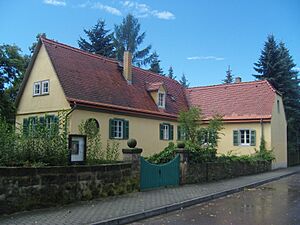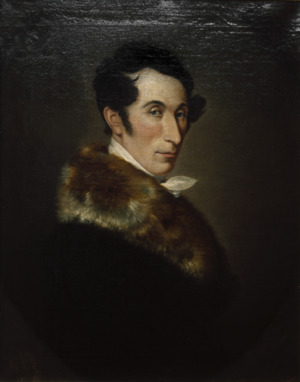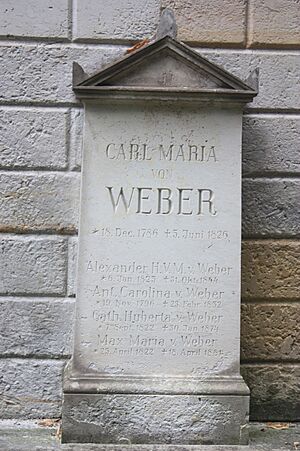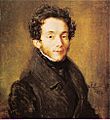Carl Maria von Weber facts for kids
Quick facts for kids
Carl Maria von Weber
|
|
|---|---|
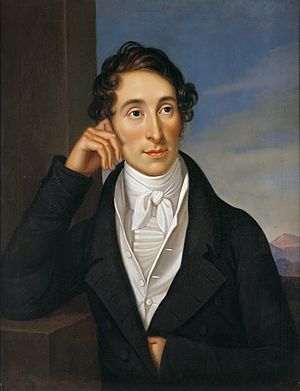
Carl Maria von Weber (1821), by Caroline Bardua
|
|
| Born |
Carl Maria Friedrich Ernst von Weber
|
| Died | June 5, 1826 (aged 39) |
| Burial place | Dresden, Germany |
| Nationality | German |
| Occupation | Composer |
| Style | Romantic |
Carl Maria Friedrich Ernst von Weber (born 18 or 19 November 1786 – died 5 June 1826) was a German composer, conductor, and amazing pianist. He was also a guitarist and music critic. Weber was one of the first important composers of the Romantic music period. He is most famous for his operas, which are like musical plays. He played a big part in creating German Romantic opera.
During his childhood, his father, Franz Anton, moved the family often. They lived in places like Hamburg, Salzburg, and Vienna. Because of this, Carl had many different music teachers. He wrote four operas, but none of them are complete today. He also wrote other music, like two symphonies and pieces for piano and clarinet. His later operas, such as Der Freischütz (1821), were very important. They influenced many German composers like Richard Wagner. His piano music also inspired Frédéric Chopin and Franz Liszt. Der Freischütz is still one of the most famous German operas.
Contents
Carl Maria von Weber's Life
His Early Years
Weber was born in Eutin, Germany. He was the oldest of three children. His parents were Franz Anton von Weber and Genovefa Weber, a singer. He was baptized Carl Friedrich Ernst, but later used the name Maria. Both his younger brother and sister died when they were babies.
His father, Franz Anton, was a musician. He wanted Carl to be a child star, like Wolfgang Amadeus Mozart. Carl was born with a hip problem and didn't walk until he was four. But even then, he was already a good singer and piano player.
Learning Music and Growing Up
Carl's father made sure he had a good education. But their family moved a lot, which often stopped his lessons. In 1796, Carl studied music in Hildburghausen. He learned from an oboe player named Johann Peter Heuschkel.
In 1797, they moved to Salzburg. There, Carl studied with Michael Haydn, who was the younger brother of the famous composer Joseph Haydn. Michael Haydn taught Carl for free. This time was sad for Carl because his mother died in 1798. His baby sister also died that year.
Later in 1798, Weber moved to Munich. He studied singing and composing there. He wrote his first opera, The Power of Love and Wine, but it is now lost. Some of his early piano pieces were published when he was just twelve.
In 1799, Weber also learned lithography. This was a new way to print pictures and text. He even printed some of his own music this way.
In 1800, his family moved to Freiberg. Carl was 14 and wrote another opera called The Silent Forest Maiden. This opera was performed in several cities. Carl also started writing articles as a music critic.
In 1801, they went back to Salzburg. Carl continued studying with Michael Haydn. He wrote his third opera, Peter Schmoll and His Neighbours. His teacher liked it very much.
In 1803, Weber went to Vienna to study with Georg Joseph Vogler. Another student of Vogler was Jakob Meyer Beer, who later became the famous composer Giacomo Meyerbeer. Weber and Meyerbeer became close friends.
Starting His Career: 1804-1810
In 1804, when Weber was 17, he became the director of the Breslau Opera. He wanted to make the opera better. He hired more musicians and tried new, harder pieces. People noticed his hard work, but some thought his music was too fast. He stayed for two years, then left to have more time for his own music.
From 1807 to 1810, Weber worked in Stuttgart. He was a private secretary for Duke Ludwig. During this time, Weber faced some difficulties, including financial problems. He and his father had to leave Württemberg. After this, Weber started keeping a diary to keep track of his money and letters.
Even with these problems, Weber wrote a lot of music. He wrote religious music, mostly for Catholic church services. He also wrote some of his most original songs. He was a skilled guitarist, and some of his early songs included guitar.
Becoming Famous: 1810-1826
In 1810, Weber traveled around Germany. The year 1811 was very important for him. He met a great clarinet player named Heinrich Baermann. Weber wrote several pieces for the clarinet, including two concertos, especially for Baermann. They went on tour together, and their concerts helped change how people saw Weber's music.
From 1813 to 1816, Weber was the director of the Opera in Prague. Then, from 1817, he became the director of the famous Opera in Dresden. He worked hard to create a strong German opera style. At that time, Italian opera was very popular in Europe. Weber wanted German opera to be just as important. He was inspired by German folk songs.
On November 4, 1817, he married Caroline Brandt. She was a singer who had performed in his opera Silvana. In 1819, he wrote his most famous piano piece, Invitation to the Dance.
His opera Der Freischütz was a huge success when it premiered in Berlin on June 18, 1821. It was then performed all over Europe. On the same morning of the premiere, Weber finished his Konzertstück in F minor for Piano and Orchestra. He performed it a week later.
In 1823, Weber wrote his opera Euryanthe. Some parts of this opera sound a bit like the early operas of Richard Wagner. In 1824, he was asked to write an opera for The Royal Opera in London. This opera was called Oberon. Weber accepted and traveled to England in 1826 to finish it. He conducted the first performance on April 12.
Weber was already sick with tuberculosis when he went to London. He conducted the premiere and twelve more sold-out shows of Oberon. Even though he was getting sicker, he kept performing in concerts.
He died in his sleep on June 5, 1826, at the age of 39. He was buried in London. Eighteen years later, in 1844, his body was moved to his family's burial place in Dresden, Germany. His youngest son, Alexander, was buried there too. Richard Wagner wrote a special song for Weber's reburial.
Weber's opera Die drei Pintos was not finished when he died. Later, Gustav Mahler completed it. Mahler conducted its first performance in 1888.
Why Is Weber Still Important?
Weber's operas, especially Der Freischütz, Euryanthe, and Oberon, were very important. They helped shape the Romantische Oper (Romantic opera) in Germany. Der Freischütz is often called the first German opera. Euryanthe used a technique called leitmotif a lot. A leitmotif is a short musical idea that represents a character or an idea. Oberon might have influenced Felix Mendelssohn's music for A Midsummer Night's Dream. Weber was also interested in music from other cultures. He used a Chinese melody in his music for Turandot. This made him one of the first Western composers to use an Asian tune.
Weber's music for clarinet, bassoon, and horn is still very popular today. His clarinet pieces, like his two concertos, are often played. His Concertino for Horn and Orchestra is special because the player has to hum while playing to make two notes at once!
Weber also wrote a lot of vocal and choral music. His religious music was very popular in Germany in the 1800s. He also wrote one of the first song cycles. A song cycle is a group of songs that tell a story or share a theme.
Weber was also one of the first conductors to lead an orchestra without playing an instrument himself. This was a new way to conduct. Composers like Hector Berlioz and Claude Debussy admired Weber's way of writing for the orchestra.
Many later composers were influenced by Weber's operas. This includes Heinrich Marschner, Giacomo Meyerbeer, and Richard Wagner. Even modern composers like Claude Debussy and Igor Stravinsky have shown respect for Weber. Gustav Mahler finished Weber's opera Die drei Pintos. Paul Hindemith wrote a famous piece called Symphonic Metamorphosis of Themes by Carl Maria von Weber. This piece uses themes from Weber's less known works.
Weber also wrote about music and was interested in folksongs. He even learned lithography to print his own music.
As a great pianist, Weber wrote four sonatas and two concertos. His Konzertstück in F minor inspired composers like Frédéric Chopin and Franz Liszt. This piece created a new way to write a one-movement concerto. Igor Stravinsky said it was the model for his Capriccio for Piano and Orchestra. Weber's shorter piano pieces, like Invitation to the Dance, were later arranged for orchestra by Berlioz. Even though his piano music is not played as often today, there are many recordings of his important works.
Weber's Amazing Music
- For a full list of Weber's works, see List of compositions by Carl Maria von Weber.
- For a detailed list of his operas, see List of operas by Carl Maria von Weber.
Images for kids
See also
 In Spanish: Carl Maria von Weber para niños
In Spanish: Carl Maria von Weber para niños


